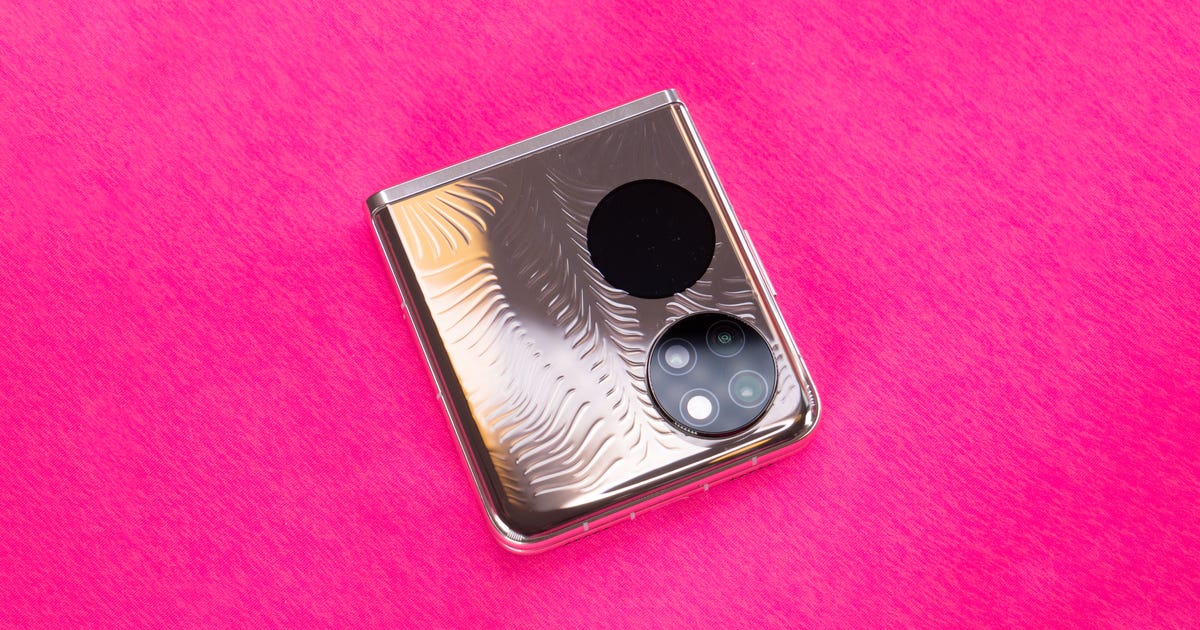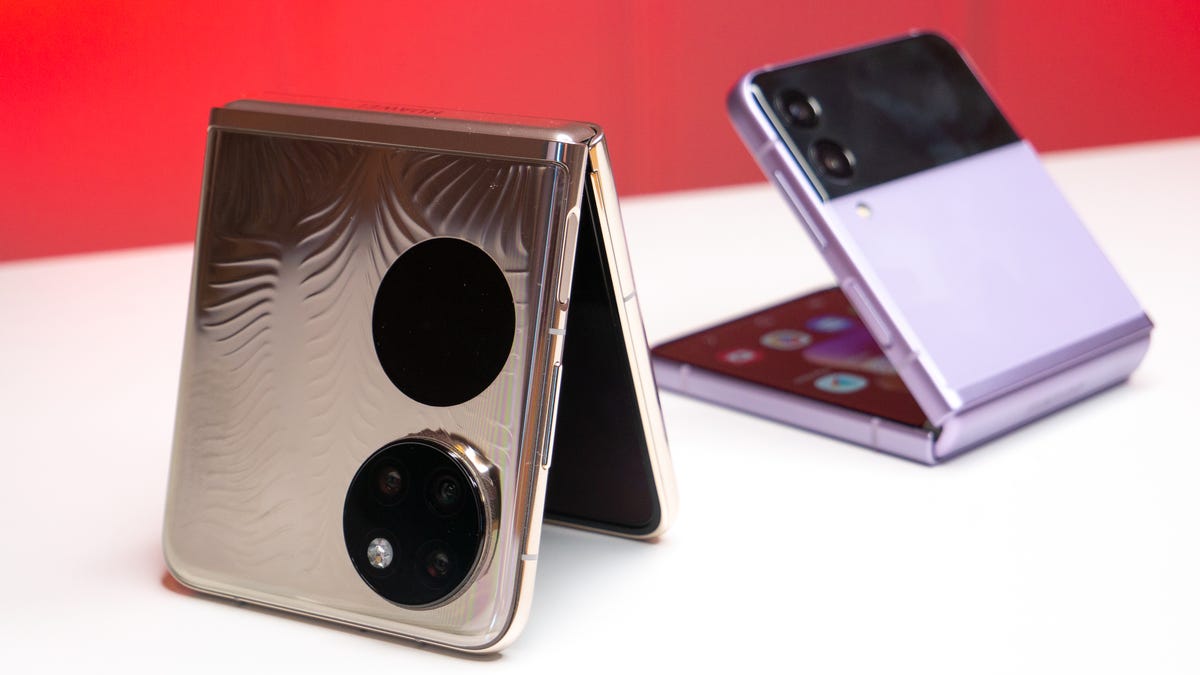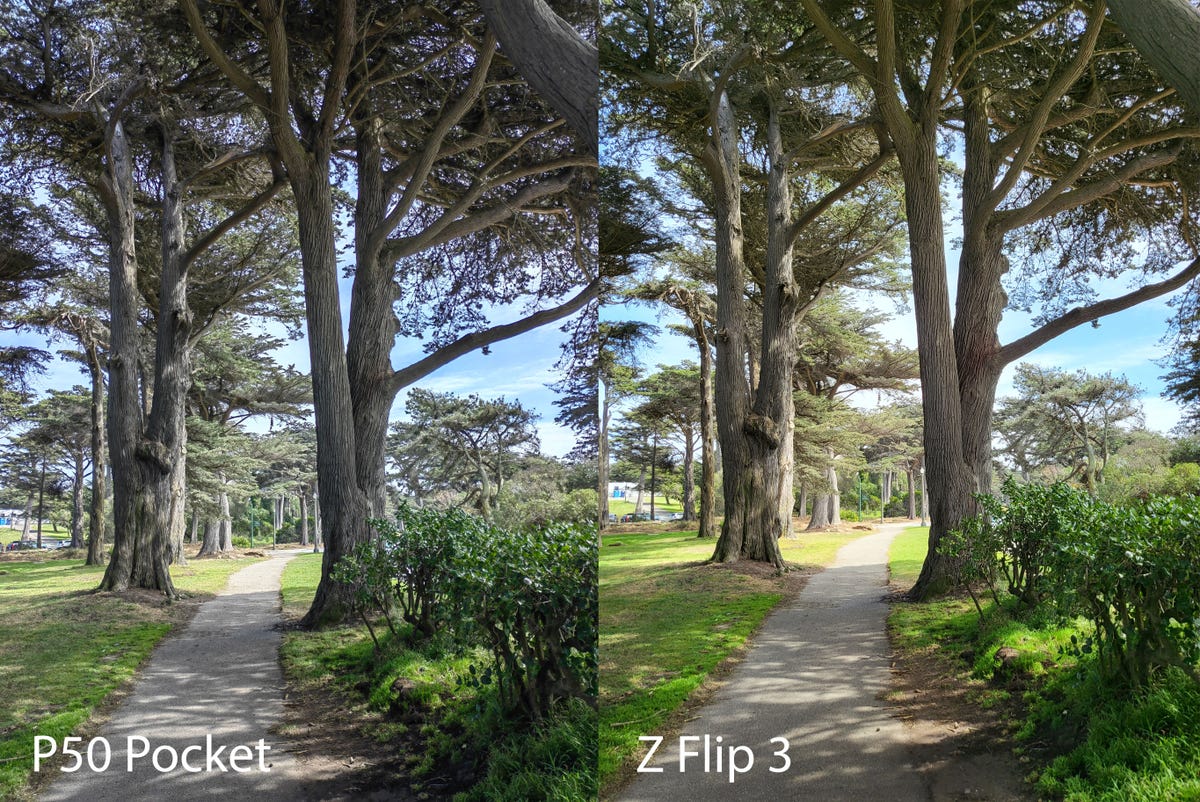
3 Things Samsung Can Learn From the Huawei P50 Pocket
The Huawei P50 Pocket is the sort of phone that will turn heads. Not only is it a foldable flip phone, but its unique patterned finish makes it feel part tech gadget, part fashion accessory. It has a different appeal that makes it stand out among other foldable phones out today. Huawei might not be able to sell the P50 Pocket in the US due to ongoing government restrictions, but it has several features that could be adopted by other flip phones we can buy.
I've been using the P50 Pocket for the past month with the Samsung Galaxy Z Flip 3 to see what the next generation of flip phones like the Flip 4 could take on board. The P50 Pocket starts at 1,299 euros (equivalent to $1,400, £1,080 and AU$1,910) but the premium gold finish on the model I've been using costs an eye-watering 1,599 euros. There's a joke here about needing deep pockets, but I'll let that one slide for now.
It's important to note that Huawei's phones can't use Google apps and services, which means no Gmail, Google Maps, YouTube or the Play Store. This puts it at an immediate disadvantage compared to other Android flip phones available today, including Samsung's phones and the Motorola Razr. Instead, it runs Huawei's EMUI 12 operating system, which is based on an open-source version of Android. There's also no 5G connectivity, a huge downside for a phone released in 2022 -- especially at this price.

It would be remiss to not mention how visually appealing this phone is, particularly in the gold etched edition.
Lexy Savvides/CNETThe P50 Pocket screen reduces the crease… and glare
Huawei's phone has a seamless hinge, the same design Motorola used on the 2020 Razr, so there's no gap between the screen when you snap it shut. There's less room for dust and debris to settle in the gap. The crease is also less prominent than on Samsung's phone, both to the eye and to the touch. When scrolling apps or web pages, I've noticed it gets under my thumb far less than the crease on the Z Flip 3. To be fair, after a few days I definitely don't notice the crease as much on the Z Flip 3, but in certain lighting conditions and when watching videos or movies, it suddenly pops back into view.
The P50 Pocket's screen is also less reflective than the Z Flip and that's something I hope Samsung really does take into consideration in the design of its next flip phone. The P50 Pocket is easier to see outside, not because of its maximum screen brightness, but because there's not as much glare thanks to the anti-reflective coating.

The P50 Pocket is easier to see outside.
Lexy Savvides/CNETThere are, of course, compromises with the hinge on the P50 Pocket as it doesn't stay open as easily as the Z Flip 3. Most native apps also aren't optimized for split screen mode either, unlike Samsung's phone.
It would be remiss to not mention how visually appealing this phone is, particularly in the gold etched edition. It's ostentatious in all the right ways and really nice to see a manufacturer taking risks with a finish like this. I also love the aesthetics of the circular display, especially how its size mirrors that of the camera module. Sometimes I look at the phone and see two googly eyes staring back, which is just fun and something I can't say about the Z Flip 3's display. Sure it's more practical for reading text notifications, but just doesn't have the same wow factor.

Googly eyes sorta included.
Lexy Savvides/CNETYou don't sacrifice camera quality on this flip phone
Camera features we take for granted today, like ultra-wide lenses, larger image sensors and low light performance, owe a lot to earlier Huawei phones like the P20 Pro and P30 Pro. Even though the P50 Pocket's cameras lack the headline-grabbing features its predecessors had, they do show that you don't need to compromise on image quality when choosing a flip phone.
The P50 Pro's main wide-angle camera has better dynamic range than the Z Flip 3. I noticed it most when taking landscapes as you can see it retains more detail in highlight areas, like the sky in the image comparison below. It also performs better for low-light shots and for video recording on the main camera at 4K/60fps.

Even at a reduced resolution you can see the P50 Pocket has better dynamic range in this shot as less detail is lost in the highlight areas in the sky.
Lexy Savvides/CNETColors on the P50 Pocket also look more natural than the Z Flip 3, which tends to over-saturate images on default settings. That's more of a personal preference than anything, but I generally preferred the images straight out of the Huawei phone. There's also a macro mode that really lets you get up close on the P50 Pocket and the ultra-wide camera has autofocus, which the Z Flip 3 lacks.
Also, the 40-megapixel sensor on the P50 Pocket lets you want to take even higher resolution images if you choose. That said, these photos don't look as good or as sharp as its 10-megapixel shots.
A bigger battery will last you the entire day
The P50 Pocket comes with a 4,000-mAh battery, a higher capacity than the dual 3,300-mAh batteries on the Z Flip 3. In my colleague Patrick Holland's review, he noted that the Z Flip 3's battery life was one of the more significant downsides. With three or four hours of screen-on time using the 120Hz display, he needed to charge the phone after 11 hours.
So the P50 Pocket's bigger battery will let you go a bit longer between charges and the phone also supports 40-watt wired charging. You do need to have the Huawei SuperCharge charger to take advantage, but even with my regular 25-watt adapter I was able to juice up the P50 Pocket from flat to full in a little over an hour. I found myself really missing this faster charging when I switched back to the Z Flip 3 that maxes out at 15 watts.
The P50 Pocket also has the option of expandable storage up to 256GB via nano memory card, which is a huge advantage for people like me who like to take lots of photos and videos.
But the P50 Pocket isn't a slam dunk… yet
Apart from the obvious issues around availability and its incredibly high price, there are several things the P50 Pocket doesn't do as well as Samsung's flip phone. The Z Flip 3 is rated IPX8 which means you can dunk it in up to 5 feet (1.5 meters) of water for up to 30 minutes. Naturally I had to test this claim for myself and spoiler alert: the phone survived. Even eight months later, I'm still using the Z Flip 3 I submerged in both fresh and chlorinated water, with no issues to report.
With the P50 Pocket, there isn't a water resistance or durability rating whatsoever. I only used the phone for a month and have been pretty careful with it during that time, but there's no way to tell how it will fare long-term -- or if I end up dropping or dunking it accidentally.
Then there's connectivity. The P50 Pocket only supports 4G LTE which is one of the biggest issues considering its price. If you're thinking of holding on to your phone for several years this could be more of a downside than you might think, especially as 5G connectivity continues to roll out across the world. Huawei's EMUI also has a significantly higher learning curve than I'd like, particularly when it comes to its aggressive battery management.
Source
Tags:
Blog Archive
-
▼
2023
(218)
-
▼
January
(86)
- Here's How A Digital Detox Will Benefit Your Menta...
- New Windows 10 May 2021 Update Is Here: How To Dow...
- Facebook's Outage Also Hit Its AR And VR Gadgets, ...
- GoPro Reveals What The GPS In The Hero5 Black Came...
- Best Valentine's Day Gifts For Kids
- Save $150 Off Apple's Recently Discontinued 256GB ...
- Private Mortgage Insurance: How PMI Works
- Snapchat's New Groups Feature Lets You Mass-send S...
- 'The Hunger Games' Prequel Movie: What You Need To...
- Here's Why The Galaxy S21 Ultra Beats Samsung's Ol...
- 9 Great Reads From CNET This Week: PS5, Apple Watc...
- Rivian Production Starts, 2022 Kia Carnival Update...
- Acer Swift 3 Review: A Better-looking Budget Laptop
- Nissan Ariya EV Orders Are Closed Indefinitely, Re...
- Oppo Launches New Camera-centric F Series
- D23 Disney & Marvel Game Showcase: Start Time, How...
- You Can Now Listen To Podcasts On Twitter
- Keep Your Coffee At The Perfect Temperature With $...
- Xiaomi: Don't Hold Your Breath For A US Phone In 2017
- Nearly 411,000 Kias Recalled For Airbag Issue
- Co-buying A Home With A Friend? Answer These 5 Que...
- Military-grade Spyware Reportedly Found On Phones ...
- Ukraine Gets Turkish Military Drone Gift After Lit...
- The New Acura Integra Will Be A Hatchback
- The Productivity Hack That's Taking Over TikTok
- AMD Radeon RX 6800 XT And 6900 GPUs Target 4K Gami...
- Walmart Plus Members Can Save Up To 40% On Chromeb...
- IOS 16 Lets You Unsend, Edit Texts On Your IPhone....
- Apple's IPad And M1 Mac Sales May Tell Us Whether ...
- Windows 11 Finally Has A Quick Way To Switch Your ...
- Top Halloween Costumes May Include Fortnite, It An...
- Huawei Cut US Components Out Of Mate 30 In Wake Of...
- Acer Nitro 5 Review: Pushing The Boundaries Of Bud...
- We Watched More TV On Streaming Than Cable For Fir...
- Asus ZenBook 13 UX333 Review: New Asus ZenBooks Pa...
- Best Buy 3-Day Sale: Last Day To Save On Microsoft...
- Inflation Isn't Slowing Down. I Bonds And Other Sa...
- Dell Inspiron 15z Review: A Budget-minded 15-inche...
- Drones, Eco Travel And More At The Gadget Show Liv...
- Pixar's 'Turning Red' Teams Up With Firefox To Cel...
- 2015 Kia Soul EV Review: Kia Creates Eco-karma Wit...
- Ken Block's Hoonipigasus Is A 1,400-HP Porsche 911...
- 3 Things Samsung Can Learn From The Huawei P50 Pocket
- 'Doctor Who' First Look Shows Jodie Whittaker In C...
- 2022 Ford Explorer Timberline Review: One For The ...
- Should You Buy An Apple Watch Right Now? It's Comp...
- Saudi Arabia Threatens To Ban Skype, WhatsApp, And...
- ESPN, Tom Brady To Launch NFT Collection
- SiFive Chip Design Challenges Arm And Leads To Int...
- Asus Confirms It's Bringing Out A Set Of Augmented...
- NFL Tries A Different Sort Of Snap: Weekly Stories...
- WWE To Crown First UK Champion, Triple H Reveals
- DJI's New $500 RC Robot Features A Camera, 31 Sens...
- Asus ROG Strix G15 Advantage Edition Gaming Laptop...
- Twitter Pushes Further Into E-Commerce With New Sh...
- 8 Science-Backed Exercises To Reduce Stress
- Adaware Antivirus Free - Free Download And Softwar...
- GoPro Hero 9 Black Hands-on: All The Tools To Tell...
- Tinder Is Bringing Back Festival Mode For Musical ...
- Mom Crochets Adorable E.T. Costume, Turns Son Into...
- 2023 Nissan Z First Drive Review: A Sports Car Ico...
- How The Apple Watch Saved My Life -- And Could Res...
- Intel's New Diversity Goals: Put Women In 40% Of T...
- Best Game Pass And Xbox Live Deals
- Samsung's New Galaxy S21 FE Will Keep The Galaxy S...
- Creators Can Save Up To 40% On CyberLink's PowerDi...
- NASA's Hubble Space Telescope Snaps Spooky Image O...
- I Could Get Hooked On This Salad Delivery Service
- How A $300K Bored Ape Yacht Club NFT Was Accidenta...
- Windows 11 Updates Getting In The Way? Take Contro...
- 'Xagent' Mac Malware Linked To Russian Group That ...
- DJI Mavic 3 Review: Great Image Quality And Batter...
- How To Pick The Right Credit Card: Use These Tips ...
- Still Sterilizing Your Baby Bottles? You Might Be ...
- 5 Ways To Tell If You're Healthy -- Without Any To...
- Is Grocery Shopping Online Cheaper Than At The Sto...
- Dell's Thin, High-res XPS 13 Laptop Does Linux
- Instagram Copies 'Anti-Instagram' App BeReal In La...
- Google Sued By Multiple States Over How It Handles...
- How To Enable Snapchat Log-in Verification
- Google Is Still No Samsung, But The Pixel 6 Might ...
- The Upgraded 2022 Moto G Stylus Is A Downgrade In ...
- Boeing Starliner Test Flight To ISS Pushed Back To...
- The Evolution Of Apple Gadgets
- Never Forget Your Reading Glasses Again With 30% O...
- Facebook Under More Scrutiny After Own Research Sh...
-
▼
January
(86)
Total Pageviews
Search This Blog
Popular Posts
-
DJI's new $500 RC robot features a camera, 31 sensors and a mini cannon DJI's new $500 RC robot features a camera, 31 s...
-
Kerastase hair loss, kerastase hair loss treatment, kerastase hair loss products, kerastase hair products, kerastase hair, kerastase hair pr...
-
Perodua axia enjin gegard, perodua axia enjin gegar vaganza, perodua axia enjin gegar fm, perodua axia enjin gegar pantai, perodua axia engi...

